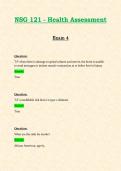NSG 121 - Health Assessment Exam 4 Question: T/F when there is damage to spinal column and nerves, the brain is unable to send messages to initiate muscle contraction at or below level of injury Answer: True Question: T/F a modifiable risk factor is type 2 diabetes Answer: True Question: What are the risks for stroke? Answer: African American, age 65 Question: Why is dysphasia concerning after a patient has had a stroke? Answer: Choking, aspiration pneumonia Question: Where is the brocas area and what is it responsible for? Answer: Frontal lobe and regulates verbal expression and writ ing ability Question: broca area (motor speech area) Answer: Regulates verbal expression and writing ability How would you communicate to a patient who has an injury to Broca's area? Answer: Pictures, whiteboard, allowing them to express their thoughts Question: Damage to the wernicke area Answer: Lead to diffic ulty understanding verbal communication, called receptive aphasia. Question: T/F a client with stupor can respond to a stimulus but will be slow to respond Answer: False - that is d rowsiness. Stupor: patient is unresponsive and can be aroused only briefly by vigorous, repeated stimulation Routine neurological assessment Answer: Assess level of consciousness, pupil response, observe gait, check 12 cranial nerves, evalu ate muscle tone Question: Routine vs. Focused Neurological Assessment Answer: Routine: assess level of consciousness, pupil response, observe gait, check checking 12 cranial nerves, evaluate muscle tone Focused: further evaluate specific abnormal findin g, deep tendon reflexes, 2 -
point discrimination, moving fingers and toes up or down with eyes closed. Question: T/F when there's damage to the spinal column, the brain is not able to send message to initiate voluntary muscle contraction at or below the level of damage Answer: True Question: T/F: Common complications in hospitalized patients include placement of chest tube Answer: False: chest tube is a common procedure, not a common complication (DVT, trauma, fall, infection)




